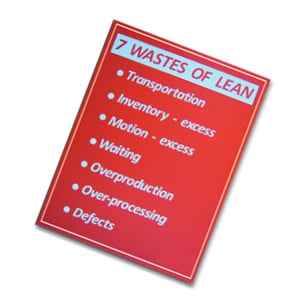 I visited a company (actually this could be many companies) recently and noticed “7 Wastes” posters displayed prominently in every department. Pointing to the waste described as “Inventory’ -- excess”, I asked my host, “How would you define excess in this case?”
I visited a company (actually this could be many companies) recently and noticed “7 Wastes” posters displayed prominently in every department. Pointing to the waste described as “Inventory’ -- excess”, I asked my host, “How would you define excess in this case?”
She thought for a moment and then replied, “About one month’s worth of inventory is good. Any more than that is a problem.”
Pointing to stacks of material that lined the shop floor, I asked, “So that inventory is good?” “Yes,” she replied, “That’s all good – it’s sold."
“So you’ve already received cash for it?” I asked. “No,” she replied impatiently, “but we will soon.”
I decided not to push the concept at that moment, but reflected on how much wiggle room is built into the word “excess.” I see the word used frequently to describe several of the seven wastes. “Excess” is used to modify the waste of Motion also. I wonder why. I’ve not yet seen a poster that allows for “excess defects”, although we might as well use that phrase too since most acceptable quality levels (AQL) are well above zero. Even six sigma provides a little wiggle room for defects.
The problem with the wiggle room is that it modifies an ideal condition to become an “acceptable” one. In the case of the company above, batches of inventory totaling one month were considered good. More or less than that amount is not especially important. What’s important is that the concept of an ideal condition has been lost.
How remarkably different the situation is in organizations that maintain the ideal: Last week, I had the pleasure of visiting with Dr. Sami Bahri at his dental clinic in Jacksonville, Florida. Dr. Bahri , who has been called the world’s “First Lean Dentist,” explained to me how he and his staff pursue the goal of “single patient flow.”
“We began with the simple procedures, like imaging and cleaning, with the goal of completing the patient’s complete procedure in a single visit. Next we added simple dental procedures, and then crowns. We’ve adopted quick changeover, pull systems and other lean methods to approach the ideal of one by one patient flow for every procedure. We’re not there yet, but we work towards the ideal every day.”
The vision of one patient flow is pervasive and persistent at the *Bahri Dental Practice* giving rise to minute-by-minute problem solving and improvement. This remarkable clinic has no place for wiggle room.
How much wiggle room do you allow in your organization? Let me hear from you.
O.L.D.
BTW. Dr. Sami Bahri will be presenting at our NE Shingo Conference, October 5-6, Springfield MA.

